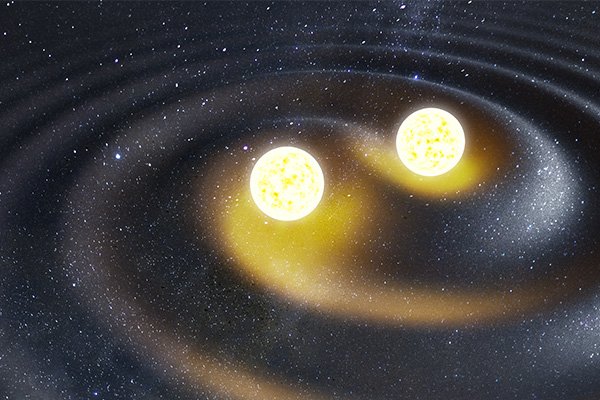Any event in the cosmos generates gravitational waves, the bigger the event, the more disturbance. Events where black holes and neutron stars collide can send out waves detectable here on Earth. It is possible that there can be an event in visible light when neutron stars collide so to take advantage of every opportunity an early warning is essential. The teams at LIGO-Virgo-KAGRA observatories are working on an alert system that will alert astronomers within 30 seconds fo a gravity wave event. If warning is early enough it may be possible to identify the source and watch the after glow.
The very fabric of space-time can be thought of as a giant celestial ocean. Any movement within the ocean will generate waves. The same is true of movements and disturbances in space, causing a compression in one direction while stretching out in the perpendicular direction. Modern gravity wave detectors are usually L-shaped with beams shining down each arm of the building. The two beams are combined and the interference patterns are studied allowing the lengths of the two beams to be accurately calculated. Any change suggests the passage of a gravity wave.

A team of researchers at the University of Minnesota have run a study that endeavours to improve the detection of the waves. Not only do they hope to improve the detection itself but also to establish an alerting mechanism so that astronomers get a notification within 30 seconds after the event detection.
The team used data from previous observations and created simulated gravity wave signal data so that they could test the system. But it is far more than just an alerting system. Once fully operational, it will be able to detect the shape of the signals, track how it evolves over time and even provide an estimate of the properties of the individual components that led to the waves.
After it is fully operational, the software would detect the wave for example from neutron star or black hole collisions. The former usually too faint to be able to detect unless its location is known precisely. It would generate an alert from the wave to help precisely pinpoint the location giving an opportunity for follow up study.

There are still many outstanding questions surrounding neutron star and black hole formation not least of which is the exact mechanism that leads to the formation of gold and uranium.
graThe LIGO (Laser Interferometer Gravitational-Wave Observatory) has just finished its latest run but the next is due in February 2025. Between recent observing runs, enhancements and improvements have been made to improve the capability of detecting signals. Eventually of course it comes down to the data and once the current run ends, the teams will get started.

